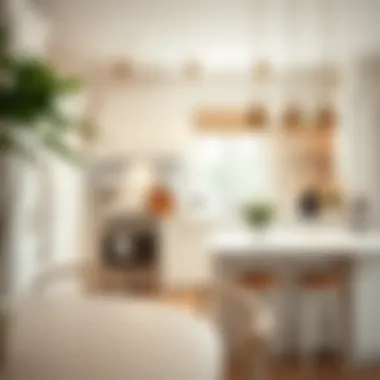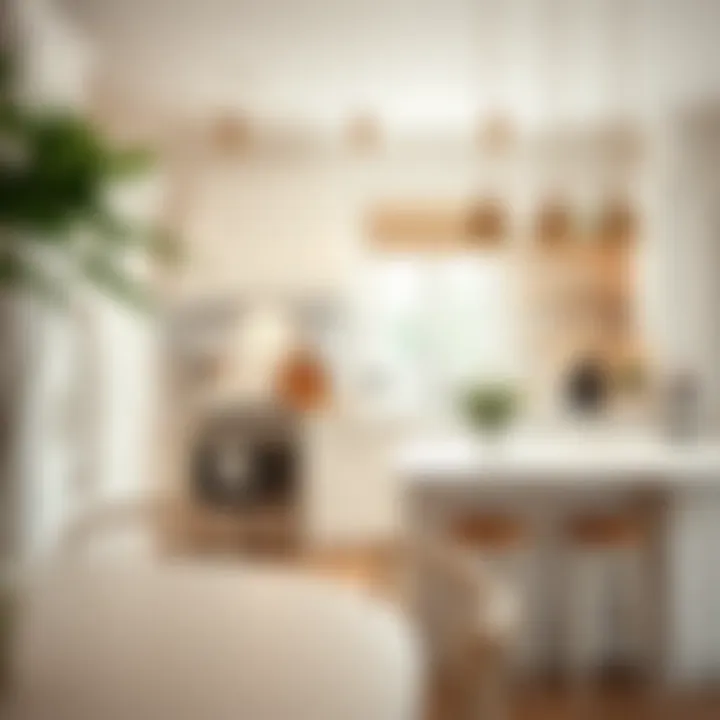Off-White Kitchens: A Blend of Style and Practicality


Intro
In recent years, off-white kitchens have surged in popularity, emerging as a top choice for homeowners looking to marry style and function. Gone are the days when stark white was the reigning champion of kitchen colors. Off-white offers a softer, warmer alternative that maintains all the elegance without the coldness sometimes associated with pure white. It creates a calming atmosphere, enticing both culinary creativity and social gatherings. More than just a trend, it represents a timeless choice that enhances the elegance of various kitchen designs while ensuring practicality.
Both aesthetics and function underpin the allure of off-white kitchens. Designers and homeowners alike recognize that color affects mood and interaction. Off-white hues can open up space, making even compact kitchens feel larger and more inviting. The beauty of off-white is its versatility; it works harmoniously with an array of materials, styles, and themes. This article intends to unravel these intricacies, guiding you through the elements that define the charming world of off-white kitchens.
Let's explore the key design trends and functional solutions that breathe life into these culinary havens.
Foreword to Off-White Kitchens
When stepping into the realm of kitchen design, colors speak volumes about the ambiance and utility of the space. Among various choices, off-white stands out as a versatile option, balancing aesthetic allure and practicality. This article emphasizes the significance of off-white kitchens, illustrating how they serve as an optimal choice for many homeowners and designers alike. The soft, neutral tone is not merely visually pleasing; it merges well with myriad décor styles while maintaining an inviting atmosphere.
Defining Off-White in Kitchen Design
Off-white is essentially a hue resting on the spectrum between white and beige, offering a warmth that stark white often lacks. It manifests in various shades such as cream, ivory, and eggshell, each presenting a unique character to a kitchen. In design discussions, defining off-white becomes crucial because selecting the right variant can dramatically affect how a space feels.
Consider, for instance, the difference between a bright, cool off-white and a softer, warmer shade. A cooler shade pairs beautifully with modern, minimalistic designs. In contrast, warm tones provide a touch of coziness, ideal for traditional or rustic kitchens. Each off-white shade brings its mood, potentially transforming a kitchen into a culinary haven or a bustling family gathering place. The key lies in blending off-white with other elements in the kitchen, making it a backdrop that complements the overall design.
The Appeal of Off-White Color Schemes
The appeal of off-white color schemes is profound and multifaceted. For many, the first attraction lies in its versatility—off-white can seamlessly transition across various styles, from chic modern to classic vintage. This adaptability makes it an undeniable favorite among designers and homeowners. Moreover, it acts as an ideal canvas for highlighting various textures, materials, and colors.
Some compelling reasons off-white stands out include:
- Enhanced Space Perception: Off-white can make even the smallest kitchens feel more spacious and open. It reflects light effectively, creating an illusion of expansiveness.
- Long-Lasting Neutrality: Unlike trendy colors that may fall out of favor, off-white remains timeless. It can evolve with changing decor trends without requiring frequent updates.
- Compatibility with Accessories: Want to add a pop of color? Off-white kitchens allow vibrant accessories, ensuring they’ll stand out rather than clash with the background.
- Psychological Comfort: According to color psychology researchers, soft tones like off-white evoke feelings of peace and tranquility, ideal for a busy kitchen environment.
"Off-white kitchens marry classic elegance with modern versatility, creating a dining space that breathes warmth and functionality."
In summary, off-white kitchens offer a harmonious blend of aesthetics and practicality. As we explore more intricate details of their design elements, we discover the real potential of these spaces, whether in practical considerations, aesthetic appeal, or psychological comfort.
The Aesthetic Value of Off-White Kitchens
The aesthetic allure of off-white kitchens transcends mere color choice. Off-white serves as a perfect blank canvas, allowing homeowners and designers alike to experiment with various styles and textures, creating eye-catching yet serene spaces. This hue bears an elegance that balances modernity and timelessness, making it a popular choice in contemporary kitchen design. Its neutrality allows for creative freedom, ensuring that the kitchen retains charm while fulfilling functional demands.
Complementary Color Palettes
Complementary color palettes are vital in achieving harmony in off-white kitchens. Different shades can add depth, vibrancy, or warmth, ultimately enhancing the beauty of the space. Let's delve into various aspects of the complementary color palettes that can work in tandem with off-white.
Neutrals
Neutrals are the unsung heroes in color palettes, functioning as a stabilizing agent in any decorating scheme. They blend seamlessly with off-white, creating a soothing, cohesive look. Using shades like gray, beige, or taupe can invite a modicum of sophistication into the kitchen without overwhelming it.
One unique feature of neutrals is their versatility; they can shift in appearance according to the light and surrounding colors, enhancing the ambiance. Although a popular choice for maintaining a serene décor, it can sometimes lead to blandness if overused. Therefore, careful selections are crucial for achieving a balanced aesthetic.
Bold Accents
Bold accents can be the splash of color that revives an off-white kitchen. Think deep blues, emerald greens, or fiery reds—these hues can inject energy into the space without compromising the overall elegance. Such accents can serve as focal points, drawing the eye and breaking the monotony of an otherwise subdued palette.
This strategy allows for personal expression while keeping the design grounded in practicality. However, balance is key; too many bold choices can cause visual chaos. It’s all about knowing which colors to use and where to position them for maximum impact.
Natural Tones
Natural tones encompass earthy shades inspired by nature. These colors—like terracotta, olive green, and soft browns—bring warmth and richness to an off-white kitchen, forging a connection with the outdoors. Natural tones can create an inviting atmosphere, enriching the space with organic undertones.
The unique feature of natural tones is their ability to evoke feelings of comfort and serenity, making the kitchen a welcoming hub for family interactions. The drawback here could be a tendency for the design to lean towards rusticity. Yet when blended thoughtfully with off-white, they can maintain an elegant, refined atmosphere.
Texture and Material Combinations
Textures and materials play a crucial role in enhancing the visual appeal of off-white kitchens. By combining various materials, designers can create a layered and engaging experience that adds character and sophistication.
Wood
Wood introduces warmth and an organic quality that softens the sleekness of off-white. Its varied grains and tones can be used in cabinetry or flooring, bringing a natural balance to the subdued color.


A key characteristic of wood is its timelessness. No matter the home's architecture, wood can complement other materials effortlessly. However, keeping wood in pristine condition may require more maintenance, especially in a kitchen setting where spills and stains are common.
Metal
Metal offers a contrasting element in off-white kitchens, adding a modern twist. Be it stainless steel appliances, brass fixtures, or copper accents—metal elements can provide a sleek, polished finish that enhances the visual interest of the kitchen.
Its durability and ease of maintenance make metals a popular choice among homeowners. Still, one must be cautious about the overuse of metallics, as it might steer the design toward a clinical feel. Balance is essential to maintain that intended warmth and charm.
Stone
Stone, in its myriad forms, can elevate the aesthetic of an off-white kitchen significantly. Granite counters or marble backsplashes introduce textures and colors that can complement any design scheme.
The unique grain patterns in natural stone can serve as conversational pieces while providing durability and resilience in high-use areas. However, the weight and expense of stone can be a deterrent. Thus, thoughtful selection becomes key to ensure it aligns with the rest of the kitchen’s aesthetic and functional needs.
Practical Considerations for Off-White Kitchens
When it comes to designing or updating a kitchen, the color scheme is just the tip of the iceberg. Off-white kitchens, while visually pleasing, require careful attention to some practical considerations. These aspects directly influence functionality, maintenance, and the overall ambiance of the space. Understanding these elements leads to a successful off-white kitchen that not only looks stunning but also serves its purpose effectively.
Lighting and Its Impact
Lighting plays a pivotal role in enhancing the aesthetics and functionality of off-white kitchens. It can affect everything from how colors are perceived to the mood created within the space. Both natural and artificial lighting should be thoughtfully incorporated into the design plan.
Natural Lighting
Natural lighting can be a game-changer in an off-white kitchen. Its contribution to creating a welcoming and airy environment is unmatched. A key characteristic of natural lighting is its ability to change throughout the day, bringing different hues and shadows that enhance the off-white tones.
- Benefits: Natural light reflects off white surfaces, making the kitchen feel more spacious and bright. This dynamic light also uplifts the mood, which is essential in a room where people gather.
- Considerations: However, it’s crucial to manage this light effectively. Too much direct sunlight can create glare or increase heat, making the kitchen uncomfortable. Using sheer curtains or strategically placed window film can mitigate these effects while enhancing the beauty of the space.
Artificial Lighting Solutions
While natural lighting is ideal, it isn’t always available to meet the needs of every kitchen. Thus, good artificial lighting solutions are essential. The unique feature of artificial lighting is that it’s adjustable and can be used to highlight particular areas of an off-white kitchen.
- Benefits: Using a mix of ambient, task, and accent lighting can help create an inviting atmosphere. For example, pendant lights over a breakfast nook not only provide practical light but also add a decorative element to the kitchen.
- Considerations: Still, care must be taken to choose the right color temperature. A warm LED light may complement off-white cabinets better than a harsh cool light, which can wash out the colors and make them seem lifeless.
Maintenance and Cleaning
Maintenance of the off-white kitchen can be a double-edged sword. While off-white shades offer understated elegance, they can also show dirt and stains more readily than darker shades. Therefore, the right approach to choosing materials and effective cleaning techniques is paramount.
Choosing the Right Materials
Selecting the proper materials can significantly simplify maintenance in an off-white kitchen. A key characteristic here is durability; materials that resist staining and wear can enhance both the kitchen's aesthetics and its longevity.
- Benefits: For instance, quartz countertops can mimic the beauty of natural stone while providing low-maintenance cleaning. This choice helps maintain that off-white sheen without constant upkeep.
- Considerations: However, not all off-white materials are created equal. Some may be more prone to scratches or staining, so thorough research into each component—like cabinetry and flooring—is necessary to avoid disappointments down the road.
Cleaning Techniques
The techniques used for cleaning an off-white kitchen will affect its long-term appearance and functionality. Effective cleaning measures can help prevent discoloration and maintain that crisp look.
- Benefits: Regular gentle cleaning with pH-balanced cleaners can go a long way in keeping surfaces looking fresh. Incidental spills should be wiped promptly to avoid permanent stains.
- Considerations: It’s crucial to avoid abrasive cleaners as they can dull the surfaces. Likewise, certain acidic substances can cause tarnishing on metals. Knowing which products to use ensures that the integrity of the off-white elements remains intact over time.
Psychological Effects of Off-White in Kitchen Spaces
Understanding the psychological effects of color in our living spaces is more than just a creative exercise; it's essential for crafting an environment that feels right. In off-white kitchens, the subtleties of color can significantly influence the atmosphere and functionality of the space. The notion that colors evoke emotions is well-known but often overlooked when designing kitchens, arguably one of the most frequented areas in the home. Off-white serves as a bridge, combining the serenity of white while bringing a touch of warmth that can elevate daily activities to an experience. This section will dive deep into how emotional responses to color can shape our culinary environments, along with creating a calming atmosphere conducive to family gatherings and culinary exploration.
Emotional Responses to Color
Colors are like a language of their own, speaking to us on emotional and psychological levels. When it comes to off-white, its softness can inspire feelings of tranquility and openness. Unlike stark white, which might feel a bit sterile, off-white brings a touch of earthiness, making it more relatable.
- Calmness: The subtle hue promotes a peaceful ambiance, ideal for anything from morning coffee to late-night cooking endeavors.
- Warmth: With undertones that often lean toward beige or cream, the space doesn’t come off as cold, inviting everyone to linger a little longer.
- Curiosity: Interesting to note, lighter colors can potentially encourage creativity. It’s a space where you might feel encouraged to experiment with new recipes or ideas.
In interviews and studies, many designers note how clients often want spaces that feel inviting yet functional, and off-white stands out as a color choice that seamlessly achieves this.
"Color is a power which directly influences the soul." – Wassily Kandinsky
This insight underlines the importance of thoughtfully considering the emotional consequences of color choices in design.


Creating a Calming Atmosphere
The concept of a calming kitchen environment is pivotal for many homeowners, especially when cooking becomes a chore rather than a joy. Off-white can contribute significantly to this goal. Here are several aspects to consider:
- Natural Light Reflection: Off-white surfaces reflect rather than absorb light, making spaces feel airy and bright. The result? A relaxed energy that helps reduce daily stressors.
- Versatile Decor Integration: This color acts as a blank canvas. It harmonizes beautifully with various materials and furnishings, allowing for personal touches that enhance a serene environment.
- Focal Points: By using off-white as a predominant color, you can create focal areas with bolder accents—be it through vibrant backsplashes or daring appliances—without those elements overwhelming the space’s tranquility.
- Functional Spaces: Whether it's seating arrangements for informal chats or comprehensive cabinetry layouts for cooking, you can design these areas to be conducive to both relaxation and functionality.
Overall, understanding and applying the psychological impacts of off-white can lead to kitchens that not only look stylish but also cater to the emotional needs of those who use them. Creating a calming atmosphere that reflects this deeper understanding can elevate kitchen design from mere construction to an integrated part of one’s life experience.
Designing an Off-White Kitchen: Best Practices
Designing an off-white kitchen primarily hinges on making choices that balance aesthetics and functionality. The right design can turn a standard kitchen into a welcoming culinary haven. Off-white, being a subtle and versatile color, offers an array of benefits that align well with various design philosophies. It's a backdrop that not only exudes elegance but also lends itself to a myriad of complementary elements, making it a favored choice for both modern and traditional spaces. In this section, we'll explore key components that contribute to creating the ideal off-white kitchen, including layout planning and how to choose the right elements for cabinetry, countertops, and backsplashes.
Layout and Spatial Planning
Work Zones
Work zones are pivotal in ensuring an efficient kitchen setup. The concept revolves around creating dedicated areas for specific tasks such as food preparation, cooking, and cleaning. Each zone is designed to facilitate a smooth workflow, minimizing unnecessary movements—the less time spent running around looking for utensils, the better.
One of the prominent traits of work zones is their ability to enhance the overall kitchen experience. This approach is a favorite amongst both homeowners and designers. It simplifies the cooking process and can significantly improve the functionality of a space. Having a clear division between prep, cook, and cleanup areas can aid in keeping the kitchen organized and make it more enjoyable to use.
However, forming these zones requires thoughtful spatial planning. The layout must consider appliance placement, counter space availability, and flow between the areas. It's essential to understand that success in this regard will depend heavily on the kitchen's total dimensions and shape. The unique feature of work zones is their ability to mimic a professional kitchen environment; it brings an element of culinary artistry into one’s home. While this approach greatly facilitates daily activities, one downside could be the potential for limitation in smaller kitchens where space is at a premium.
Flow Patterns
Flow patterns refer to the natural movement through the kitchen space, dictating how easily one can navigate from one area to another. A well-planned flow ensures that all elements, from the fridge to the stovetop, are in close proximity, creating an intuitive navigation experience.
An important feature of flow patterns is their impact on the kitchen's efficiency. This aspect often gets a nod for being an essential part of designing an effective kitchen. When everything is streamlined, it makes cooking less of a chore and more of a joy. Ensuring that the pathway between zones is unobstructed means less hassle while juggling various tasks, especially during busy meal preparation times.
However, finding that perfect flow can sometimes present challenges. For instance, in open-concept designs, the kitchen may blend too seamlessly with living areas, causing distractions. Interestingly, even minor adjustments, like the placement of an island or a dining table, can sway how fluidly one can move about. Ultimately, creating logical flow patterns represents a significant advantage in achieving a harmonious kitchen environment.
Incorporating Off-White Elements
Cabinetry
Cabinetry plays a major role in shaping the character of an off-white kitchen. When chosen thoughtfully, it can harmonize with the overall aesthetic and enhance functionality. Off-white cabinetry resonates beautifully with a range of design styles—from classy to contemporary. Its neutrality provides a great foundation for adding pops of color or intricate details, making it versatile.
The key characteristic of off-white cabinetry is its ability to reflect light, thereby giving an illusion of a larger, airier space, which can be particularly valuable in compact kitchens. Nonetheless, while it offers a graceful look, a common critique could be that it may require more regular upkeep to keep blemishes at bay. However, opting for finishes like matte or satin can mitigate this concern while maintaining beauty.
Countertops
Countertops are another pivotal element in the layout of an off-white kitchen. The choice of materials for countertops can extend the design conversation, impacting both style and utility. Whether it be quartz, granite, or a less traditional option like reclaimed wood, countertops can either complement or contrast the off-white cabinetry beautifully.
A standout feature of off-white countertops lies in their adaptability. They can blend seamlessly with other elements, allowing for creative personalization. The variety of textures it can present, from sleek to rustic, adds depth to the kitchen design. However, one must keep in mind that some materials may not withstand heat or scratches as others might. This underlines the need for careful selection tailoring to one's specific kitchen usage.
Backsplashes
Backsplashes are often an overlooked yet integral aspect of kitchen design. They serve both protective and aesthetic functions, ensuring that the walls remain damage-free while also providing an opportunity to create a focal point. In the context of off-white kitchens, backsplashes can play a critical role in creating contrast or enhancing the overall theme.
A unique feature of backsplashes is the varied materials available for selection. From ceramic tiles to natural stone, each option can dramatically change the kitchen's look. Additionally, intricate patterns can provide a striking contrast to otherwise subdued cabinets. A potential disadvantage could arise from using overly busy or dark backsplashes in an off-white kitchen, which might detract from its airy quality. Thus, one should aim for cohesive choices that elevate the overall aesthetic, ensuring that all elements work in concert rather than compete.
"The kitchen is the heart of the home; ensure its design reflects both beauty and functionality."
By focusing on these best practices, homeowners can turn their vision of an off-white kitchen into a reality that is as functional as it is inviting.
Trends in Off-White Kitchen Design
Off-white kitchens have carved a significant niche in today's design landscape, merging aesthetics with functionality in a way that appeals to homeowners and professionals alike. As trends evolve, it's crucial to keep an eye on how the off-white palette adapts to modern sensibilities. In this section, we'll discuss key trends that shape off-white kitchen design, which reflect changing tastes and advancements in materials and techniques.
Modern Minimalist Approaches
In recent years, minimalism has surged in popularity, blending effortlessly with off-white kitchen designs. This approach emphasizes the less is more philosophy, focusing on simplicity without sacrificing elegance. The integration of off-white tones in a minimalist kitchen creates a soothing environment while making space feel larger and airier. The benefits of modern minimalism in off-white kitchens include:
- Clarity: Off-white provides a neutral backdrop, allowing for cleaner lines and uncluttered spaces.
- Timelessness: The minimalist style transcends trends, making off-white kitchens always in vogue.
- Versatility: Off-white works harmoniously with a range of design elements—from sleek cabinetry to natural wood accents.


To achieve a modern minimalist look, consider:
- Utilizing flat-panel cabinetry devoid of ornate detailing.
- Incorporating open shelving to display carefully curated dishware or plants without overcrowding.
- Choosing sleek, stainless steel appliances that complement off-white finishes.
"A well-designed kitchen should focus on functionality—especially in a minimalist space, where every element must earn its place."
Vintage and Rustic Interpretations
Conversely, the charm of vintage and rustic interpretations remains a captivating trend in off-white kitchen design. This style artfully blends nostalgia with contemporary functionality. Off-white serves as the perfect canvas for showcasing rugged materials and antique finishes, adding depth and character. Here are a few points about this trend:
- Warmth: Off-white enhances natural materials like reclaimed wood and vintage tiles, creating a comforting atmosphere.
- Character: Utilizing antique fixtures like brass handles or ceramic sinks brings storytelling elements into the space.
- Layers of Texture: Pairing off-white with various textures—such as woven baskets or linen drapes—adds visual interest and warmth.
For those looking to embrace this trend, consider:
- Incorporating barn-style doors or open beams that highlight rustic charm.
- Exploring subway tiles with hand-crafted finishes that exude vintage appeal.
- Mixing different styles of seating around an off-white island, such as a modern bar stool next to a shabby-chic chair.
The interplay of off-white with rustic elements can create a harmonious atmosphere where functional cooking meets inviting family gatherings.
Relevant Links
- Wikipedia - Kitchen Design
- Britannica - Interior Design
- Reddit - Interior Design Discussions
- Gov - Sustainable Kitchen Designs
- Edu - Architectural Trends
Case Studies: Exemplary Off-White Kitchens
Case studies serve as real-world examples that anchor design principles to practical implementation. They’re where theory meets action, helping readers to visualize how off-white kitchens can be transformed into stunning spaces. From urban chic aesthetics to cozy country-styled comfort, these case studies provide insight into the versatility of off-white kitchens. They illustrate not just the visual appeal but also functional benefits that accompany thoughtful design choices.
Urban Chic Designs
Urban chic off-white kitchens take inspiration from bustling city life while promoting a sense of sleek functionality. These spaces often blend modern materials with vintage elements, resulting in stunning contrasts that create memorable culinary environments. Imagine open floor plans filled with natural light that dances on an off-white backsplash, reflecting the vibrant energy of city living.
- Key Features:
- Minimalist Approach: Utilizing streamlined cabinetry, these kitchens often feature hidden appliances that enhance the overall clean aesthetic.
- Mixed Materials: Pairing off-white finishes with elements like stainless steel and reclaimed wood introduces depth and character.
- Bold Lighting Fixtures: Industrial-style pendants or sculptural chandeliers draw the eye up, breaking the monotony of flat surfaces and drawing focus on the space’s height.
The potential here is enormous. For example, a high-rise apartment kitchen might combine off-white cabinetry with dark granite countertops, creating a striking contrast that is not only stylish but also practical. Storage solutions, such as shelves with decorative objects or live plants, can further elevate the overall charisma. These elements combined result in a kitchen that is not just a place for cooking, but a social hub where well-designed aesthetics lead the way to interaction and enjoyment.
Country-Style Kitchens
On the flip side, country-style kitchens exude warmth and charm, making them a favorite among many homeowners. Off-white kitchens in this style resonate with nostalgia and comfort, often reminiscent of family gatherings around the dinner table. Here, the off-white palette works harmoniously with rustic textures such as barn wood, exposed beams, and handmade tile.
- Key Features:
- Natural Detailing: From butcher block countertops to farmhouse sinks, these kitchens often utilize natural materials that speak to a simpler time.
- Open Shelving: Displaying dishes or mason jars enhances the inviting nature of country-style kitchens, bringing a personal touch to functionality.
- Seasonal Decor: By using off-white as a neutral backdrop, adding seasonal decorations becomes much easier; imagine a splash of autumn hues or spring flowers against a soft, off-white canvas.
Consider a quaint cottage adorned with off-white cabinetry, complemented by sage-green walls and terracotta tiles. This aesthetic invites relaxation and ease, perfect for family dinners or quiet moments with a cup of tea. The balance between practicality and design makes this style notably appealing for those who treasure both form and function.
"Case studies in off-white kitchens illustrate how thoughtful design can create spaces that are not only beautiful but also deeply functional, catering to the needs of modern life."
By exploring these case studies, readers can derive inspiration for their off-white kitchen journeys. Both urban chic and country-style examples highlight how adaptable off-white can be while maintaining an element of beauty that transcends fleeting trends.
Culmination: The Future of Off-White Kitchens
As we consider the evolution of kitchen design, off-white kitchens stand out prominently. They offer a flexible backdrop that accommodates both traditional and modern aesthetics. This versatility is a key reason they have remained in vogue and are likely to continue capturing the hearts of homeowners and designers alike.
The significance of off-white kitchens lies not just in their pleasing visuals but also in their practicality. These kitchens serve as a blank canvas, allowing homeowners to showcase personal style. The neutrality of off-white enables endless combinations with colors and textures, making it easy to adapt to shifting trends or personal preferences.
Moreover, as we move forward, sustainability is becoming a cornerstone in design choices. There’s a growing consciousness around eco-friendly materials and practices in kitchen construction and renovation. Incorporating sustainable options without compromising on aesthetics can be a balancing act, but off-white tones lend themselves well to minimizing visual clutter, helping to integrate more organic designs that fade seamlessly into their surroundings.
Sustainability and Eco-Friendly Choices
When discussing the future of off-white kitchens, we inevitably touch on sustainable practices. This is not merely a passing trend; it’s a fundamental shift in how we perceive our spaces. Homeowners are becoming more educated about their choices, seeking out materials that are not only beautiful but also responsible.
Some key actions include:
- Choosing eco-friendly cabinetry: Brands like IKEA are utilizing sustainable wood from responsibly managed forests. This practice minimizes the environmental footprint without skimping on quality.
- Incorporating recycled materials: Countertops made from recycled glass or reclaimed wood are not only stylish but help reduce waste.
- Energy-efficient appliances: Opting for Energy Star-rated kitchen appliances can drastically decrease energy use, which is both cost-effective and environmentally friendly.
- Organic finishes: Paints and stains that are low in volatile organic compounds (VOCs) contribute to better air quality and a healthier home.
Similarly, when considering the appeal of off-white, it becomes evident that this color palette promotes a fresh and clean feel. It encourages lighter spaces that reflect sunlight, thus reducing the need for extensive lighting during the day.
"A thoughtfully designed kitchen can encapsulate functionality and beauty, leading to a space that is not only pleasing to the eye but also aligns with sustainable living practices."
For interior designers and architects alike, the integration of sustainability into off-white kitchens becomes a selling point. It paves the way for clients looking for modern solutions that resonate with their values while maintaining aesthetic appeal. Ultimately, the future of off-white kitchens lies in this harmonious blend of beauty, functionality, and environmental responsibility.















